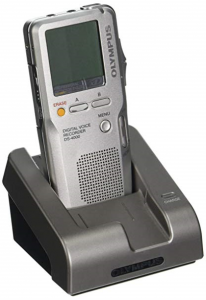So you’ve made the decision to dictate your letters or notes using a digital recorder. Now you have to pick the right one for the job. There are several things to consider.
- What do you want it for?
- What audio formats does it support?
- How good is the audio quality?
Digital Note Takers
First, there’s a difference between digital note takers (also known as voice tracers) and a digital recorder. The most obvious difference between a digital note taker and a digital recorder is the price. Digital note takers can sell for as little as $45. They are great for on-the-go recording of lists you want to be able to listen to later, to make note of a website, address or particular product you want to research later. They’re great for a quick recording you want to share with someone later. You can even play at being a shower diva. But they are not for use in transcription equipment. Often times, the specifications won’t list the type of audio file that they record in. And most digital note taker audio files will not play in transcription software, so the audio files cannot be transcribed. One such option is the Phillips Voice Tracer 2510. It does record in .mp3, one of the more common audio formats.
Some features to look for in a digital note taker include being easy to download the audio files to your computer, enough internal memory to store your audio files, easy charging (preferable to having to replace batteries) and reasonable voice quality.
Digital Recorders
For medical transcription, you need a digital recorder. Digital recorders record in stereo, with high quality audio and many more features than digital note takers. And most importantly, the audio formats in transcription software. The price for digital recorders starts as low as $200, but the better ones that are most popular for physicians and other healthcare practitioners are in the $500 – $700 range. The good news is that they can last for years and years with proper care.
 Digital recorders are excellent for dictating medical notes, records and medicolegal reports. In addition to playing in transcription software, the audio files can also be played in speech recognition software. Before selecting a digital recorder, talk to your transcriptionist or medical transcription company and find out if they have any specific requirements, such as only supporting particular audio file formats. As different manufacturers support different audio formats, let them know if you plan on changing your digital recorder, as they may have to adjust settings in the transcription software to support a different audio format.
Digital recorders are excellent for dictating medical notes, records and medicolegal reports. In addition to playing in transcription software, the audio files can also be played in speech recognition software. Before selecting a digital recorder, talk to your transcriptionist or medical transcription company and find out if they have any specific requirements, such as only supporting particular audio file formats. As different manufacturers support different audio formats, let them know if you plan on changing your digital recorder, as they may have to adjust settings in the transcription software to support a different audio format.
If you want to use a digital recorder to record interviews, do a trial interview first. Listen to it yourself for volume and clarity. Pay special attention to eliminating as much background noise as possible, and to have the volume of each speaker be similar. Identify each person in the interview at the beginning, spelling their names. And ask speakers to identify themselves each time they speak (first name or a number), so that the transcriptionist knows how to label each section of the interview. And investing in a special multi-directional microphone may help improve the audio quality.
possible, and to have the volume of each speaker be similar. Identify each person in the interview at the beginning, spelling their names. And ask speakers to identify themselves each time they speak (first name or a number), so that the transcriptionist knows how to label each section of the interview. And investing in a special multi-directional microphone may help improve the audio quality.
Some features you want to pay attention to include:
- File format – for example, .dss and .ds2 formats record in smaller file sizes and are faster to upload for transcription. Additionally, there are .wav, .wma and .mp3 formats, as well as other less common ones.
- Editing functions such as insert and overwrite
- Ergonomic design – top end models usually have a slide switch for easy operation
- Docking station for quick battery charging and easy upload to your computer
- Storage – is it all internal or on a removable chip and can you purchase additional chips if you choose to not delete recordings (e.g. for legal reasons in court proceedings)
For a review of digital recorders, check out our article at https://www.2ascribe.com/articles/digital-recorders/digital-recorders-update-2017.
And give some consideration to security. Can you password protect the recorder or files? Otherwise, if you lose (or it’s stolen), it may compromise patient identifiable information. A good practise is to delete all recordings from the digital recorder once they have been uploaded to your computer and sent for transcription.
At 2Ascribe Inc., we support all professional audio formats for medical transcription. Our secure client portal, WEBscribe, allows for the secure upload of audio files for transcription. And at 2Ascribe, while we don’t sell digital recorders, we’re happy to help you select a knowledgeable supplier or choose a digital recorder that will work for you.
2Ascribe Inc. is a medical transcription services agency located in Toronto, Ontario Canada, providing medical transcription services to physicians, clinics and other healthcare providers across Canada. Our medical transcriptionists take pride in the quality of your transcribed documents. WEBscribe is our client interface portal for document management. 2Ascribe continues to implement and develop technology to assist and improve the transcription process for physicians and other healthcare providers, and recently introduced AUTOfax. AUTOfax works within WEBscribe to automatically send faxes to referring physicians when a document is signed off by the healthcare professional. As a service to our clients and the healthcare industry, 2Ascribe offers articles of interest to physicians and other healthcare professionals, medical transcriptionists and office staff, as well as of general interest. Additional articles may be found at http://www.2ascribe.com.

